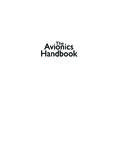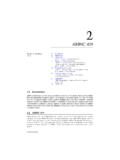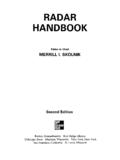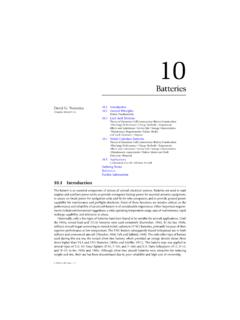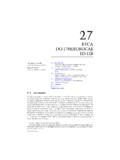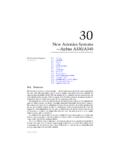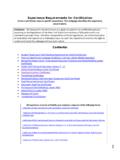Transcription of Certification of Civil Avionics - ...::: www.davi.ws
1 2001 by CRC Press LLC 23 Certification of Civil Avionics Int roduction Regulatory Basis of the Federal Aviation Administration FAA Approvals of Avionics Equipment Technical Standard Order Supplemental Type Certificate Type Certificate, Amended Type Certificate, and Service Bulletin FAA Designees System Requirements Safety Assessment Environmental Qualification Software Assurance Manufacturing Approvals The Joint Aviation Authorities Summary Defining Terms Further Information Introduction Almost all aspects of the design, production, and operation of Civil aircraft are subject to extensiveregulation by governments. This chapter describes the most significant regulatory involvement a devel-oper is likely to encounter in the Certification of is a critical element in the safety-conscious culture on which Civil aviation is based.
2 Thelegal purpose of Avionics Certification is to document a regulatory judgment that a device meets allapplicable regulatory requirements and can be manufactured properly. At another level, beneath thelegal and administrative machinery of regulatory approval, Certification can be regarded differently. Itcan be thought of as an attempt to predict the future. New equipment proposed for Certification hasno service history. Certification tries, in effect, to provide credible predictions of future service experi-ence for new devices their influences on flight crews, their safety consequences, their failure rates,and their maintenance needs. Certification is not a perfect predictor, but historically it has been quitea good this chapter, for the most part, Certification activities appropriate to the Federal AviationAdministration (FAA) are discussed.
3 However, be aware that the practices of Civil air authorities elsewhere,while generally similar to those of the FAA, often differ in detail or scope. Toward the end of this chapter, Frank McCormick Certification Services, Inc. 2001 by CRC Press LLC some differences between the FAA and the European Joint Aviation Authorities, or JAA, headquarteredin Hoofddorp, the Netherlands, will be misunderstandings can result from differences among regulators. Moreover, the rules andexpectations of every authority, the FAA included, change over time. For current guidance, authoritativesources should be chapter discusses the following topics: The FAA regulatory basis The Technical Standard Order (TSO) system for equipment approval The Supplemental Type Certificate (STC) system for aircraft modification Use of FAA designees in lieu of FAA personnel System requirements definition Safety assessments Environmental qualification Software assurance Production approvals The Joint Aviation AuthoritiesConceptually, the Certification of Avionics is straightforward, indeed almost trivial: the applicant simplydefines the product, establishes its regulatory requirements, and demonstrates that those requirements havebeen met.
4 The reality is, of course, more is a truism that for any proposed Avionics system a suitable market must exist. As with any commercialpursuit, adequate numbers of Avionics units must be sold at margins sufficient to recover investmentsmade in the product. Development costs must be controlled if the project is to survive. Warranty andsupport costs must be predicted and managed. The choices made in each of these areas will affect andbe affected by chapter is an introduction to Certification of Avionics . It is not a complete treatment of the important topics are discussed only briefly. Many situations that come up in real-life certificationprojects are not engineering should not be confused with good Certification . A new Avionics device can bebrilliantly conceived and flawlessly designed, yet ineligible for Certification .
5 Good engineering is a pre-requisite to good Certification , but the two are not has a strong legalistic element and is more craft than science. Almost every project raisessome odd regulatory-approval quirk during its development. Certification surprises are rarely pleasant,but surprises can be minimized or eliminated by maintaining open and honest communication with thecognizant regulators. Regulatory Basis of the Federal Aviation Administration The FAA, created in 1958, acts primarily through publication and enforcement of the Federal AviationRegulations, or FARs. FARs are organized by sections known as Parts. The FAR Parts covering mostavionics-related activity are listed below: Part 1 Definitions and Abbreviations Part 21 Certification Procedures for Products and Parts Part 23 Airworthiness Standards: Normal, Utility, Acrobatic, and Commuter Category Airplanes Part 25 Airworthiness Standards: Transport Category Airplanes Part 27 Airworthiness Standards: Normal Category Rotorcraft Part 29 Airworthiness Standards: Transport Category Rotorcraft Part 33 Airworthiness Standards: Aircraft Engines 2001 by CRC Press LLC Part 34 Fuel Venting and Exhaust Emission Requirements for Turbine Engine-Powered Airplanes Part 39 Airworthiness Directives Part 91 General Operating and Flight Rules Part 121 Operating Requirements.
6 Domestic, Flag, and Supplemental Operations Part 183 Representatives of the AdministratorOnly a subset of these regulations will apply to any given project. Much of the job of managing acertification program well lies in identifying the complete but minimum set of regulations applicableto a project. FAA Approvals of Avionics Equipment The FARs provide several different forms of approval for electronic devices installed aboard Civil these, most readers will be concerned primarily with approvals under the Technical Standard Order(TSO) system, approvals under a Supplemental Type Certificate (STC), or approvals as part of a TypeCertificate, Amended Type Certificate, or Service Bulletin.* Technical Standard Order An approval under the Technical Standard Order (TSO) system is common. TSOs are regulatory instrumentsthat recognize the broad use of certain classes of products, parts, and devices.
7 TSOs apply to more thanavionics; they can apply to any product with the potential for wide use, from seat belts and fire extin-guishers to tires and oxygen masks. Indeed, that is the guiding principle behind TSOs they must bewidely useful. Considerable FAA effort goes into the sponsorship and adoption of a TSO. The agencywould have little interest in publishing a TSO for a device with limited contain product specifications, required data submittals, marking requirements, and variousinstructions and limitations. Many TSOs are associated with Avionics : flight-deck instruments, commu-nications radios, ILS receivers, navigation equipment, collision avoidance systems, and flight data record-ers, to name just a , Airborne Multipurpose Electronic Displays, is representative of Avionics TSOs. Electronicdisplay systems are used for various purposes: display of attitude, airspeed, or altitude, en route navigationdisplay, guidance during precision approach, display of engine data or aircraft status, maintenance alerts,passenger entertainment, and so on.
8 The same physical display device could potentially be used for anyor all of these functions, and on many different aircraft types. Recognizing this broad applicability, theFAA published TSO-C113 so that developers could more easily adapt a generic display device to a varietyof applications. TSO-C113 is typical, calling out requirements for the following data: Explanation of applicability Exceptions and updated wording References to related regulations, data, and publications Requirements for environmental testing Requirements for software design assurance Requirements for the marking of parts Operating instructions Equipment limitations Installation procedures and limitations Schematics and wiring diagrams Equipment specifications *Newly developed equipment has sometimes been installed as part of a field approval under an FAA Form 337,though this has become rarer and is disallowed in most cases.
9 2001 by CRC Press LLC Parts lists Drawing list Equipment calibration procedures Corrective maintenance proceduresWhen an Avionics manufacturer applies for a TSO approval, and the manufacturer s facilities and datacomply with the terms of the TSO, the manufacturer receives a TSO Authorization from the FAA. A TSOA uthorization represents approval of both design data and manufacturing rights. That is, the proposeddevice is deemed to be acceptable in its design, and the applicant has demonstrated the ability to produceidentical TSO-based projects, the amount of data actually submitted to the FAA varies by system type, bythe FAA s experience with particular applicants, and by FAA region. In one case, an applicant might berequired to submit a great deal of Certification data; in another, a one-page letter from an applicant mightbe adequate for issuance of a TSO Authorization.
10 On any new project, it is unwise to presume that allregulatory requirements are known. Consistency is a high priority for the FAA, but regional differencesamong agency offices do exist. Early discussion with the appropriate regulators will ensure that theexpectations of agency and applicant are mutually understood and agreed more information on TSOs, see FAA Advisory Circular 20-110J, Index of Aviation TechnicalStandard Orders; FAA Order , TSO Minimum Performance Standard; and FAA Order , Technical Standard Order Procedures. Note that a TSO does not grant approval for installation in an aircraft. Although data approved undera TSO can be used to support an installation approval, the TSO Authorization itself applies only to theequipment in question. Installation approvals must be pursued through other means (see next section)and are not necessarily handled by an Avionics equipment manufacturer.
